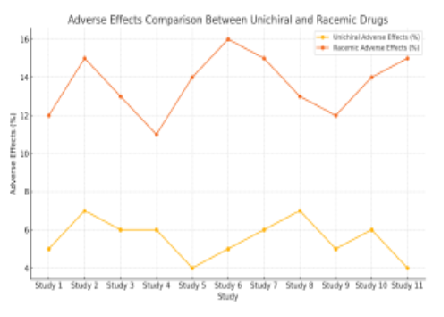


Journal of Pharmaceutical Research
Year: 2024, Volume: 23, Issue: 4, Pages: 204-214
Systematic Review
Arbind Kumar Chaudhary1,∗, A Sudhindra Prathap2, Reetesh Kumar Rai3, Feroz Khan4
1Assistant Professor of Pharmacology, Government Erode Medical College and Hospital, Tamil Nadu, India
2Tutor, Dept of Pharmacology, SDM college of medical sciences and hospital, Dharwad, Karnataka, India
3Associate Professor, Dept. of Pharmacology, MRA Medical College, Ambedkar Nagar, UP, India
4Assistant Professor of Anatomy, Government Erode Medical College and Hospital, Tamil Nadu, India
*Corresponding Author
Email: [email protected]
Background: Chirality is an essential property of several molecules and a topic on which depend most medicinal chemistry works, that influence the biological activity of drugs . Unichiral drugs, which are defined to be two enantiomers that differ only in the absolute configuration at a single chiral centre, are an important class in the pharmaceutical industry arguably offering superior therapeutic efficacy and lower side effects compared to their racemic counterparts. This systematic review will evaluate the therapeutic uses and pharmaceutical aspects of unichiral drugs by combining the existing literature record to discuss their implications for drug development and clinical use. Methods: Databases were searched using a structured approach according to PRISMA guidelines for systematic searches. This Review comprises 11 original research studies that were identified on the basis of predefined criteria pertaining to unichiral drugs. There were two phases to data extraction, consisting of qualitative and quantitative analyses and quality appraisals referring to the overall credibility of the studies. Result: Unichiral drugs were obtained to be more enantiomerically pure, bioavailable and therapeutically effective than the racemates. Unichiral presentations, especially reduced side effects and subsequently improved patient adherence. Comprehensive cross-study comparisons showed that unichiral drugs display a number of distinct therapeutic benefits, paving the way for discovery of new pharmacotherapies. This review highlights the relevance of unichiral drugs in current medicine and promotes further investigation on their innovation and regulatory pathways. Long-term clinical effects, cost-effectiveness as well as new synthesis method development in order to improve unichiral drugs production should be further studied. Conclusion: Enantiopure drugs represent an attractive frontier of drug development, offering unequivocal advantages over racemic formulations. Clinical evidence to support unichiral strategy was accumulated for improvement of efficacy and reduction of adverse effect.
Keywords: Chirality, Pharmacology, Pharmaceutical sciences, Drugtherapy interaction, Drug development, Therapeutic applications, Enantiomeric purity, Unichiral drugs, Bioavailability, Clinical efficacy
© 2024 Published by Krupanidhi College of Pharmacy. This is an open-access article under the CC BY-NC-ND license (https://creativecommons.org/licenses/by-nc-nd/4.0/)
Subscribe now for latest articles and news.